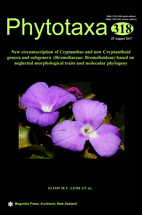Abstract
The authors provide a new circumscription for genera of the “Cryptanthoid complex” of Bromeliaceae subfam. Bromelioideae, originally composed of Cryptanthus, Lapanthus, Orthophytum, and Sincoraea, on the basis of new or re-evaluated ecological, geographical and morphological evidence, as well as molecular phylogenies. A new generic status is proposed for Cryptanthus subg. Hoplocryptanthus and two new genera, Forzzaea, and Rokautskyia, as well as four new subgenera in Orthophytum (Capixabanthus, Clavanthus, Krenakanthus, and Orthocryptanthus) are described to render taxonomic units monophyletic. The recognized taxa are well circumscribed by the combination of geographical range, ecology and morphological characters (sex distribution, leaf succulence, sepal and petal size and connation, petal appendages, pollen and stigma morphology, fruit size, calyx persistency, seed size and number per fruit). Field collected living specimens of 78 of the 81 species of Cryptanthus s.l., all species of Lapanthus, 58 of the 59 species of Orthophytum, and all species of Sincoraea were analysed in habitat and/or in cultivation, allowing the documentation and illustration of new and underutilized characters. The molecular analysis incorporated 91 accessions representing 33 species of Cryptanthus, all species (3) of Lapanthus, 42 species of Orthophytum, and 9 species of Sincoraea, including the type species for the first three genera and four outgroup taxa. The results suggest, that some morphological characters generally considered homoplasious for Bromelioideae, for the “Cryptanthoid complex”, are not homoplasious at least within the obtained, biogeographycally well delimited clades and their taxonomical utility is redeemed.

